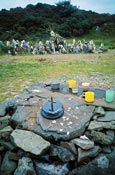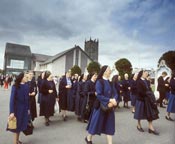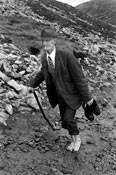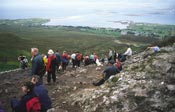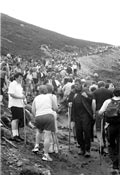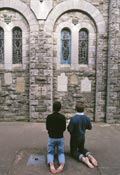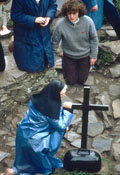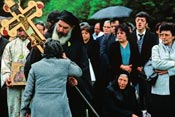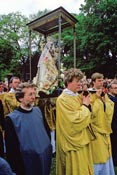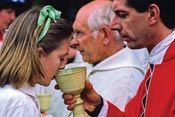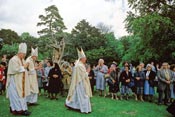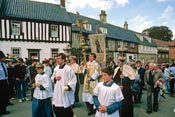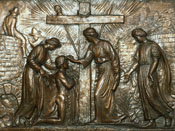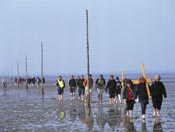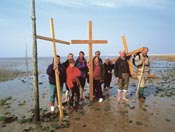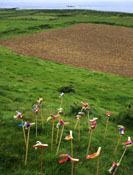
It is claimed that ‘there is hardly a Catholic family in Co Donegal without a bottle of Doon Water’. Hmm. Doon Holy Well, at Termon about 20 miles NW of Letterkenny, was established in the 15th century by one Lecter O’Friel who had remarkable curative powers, which he bequeathed to the water in the well. Thousands still come to the well every year, especially on New Year’s Eve and May Eve, to drink the holy water and take it away for relatives and friends too infirm to come themselves. They also leave offerings in thanks for cures.
Knock in Co Mayo was the scene on 21 August 1879 of an appearance by The Virgin Mary, St James and St John the Evangelist outside the parish church. Fifteen people saw this Apparition, and managed to convince a high-powered ecclesiastical commission of enquiry to such an extent that Knock has been a place of pilgrimage, on an industrial scale, ever since. Pope John Paul II himself was there in 1979. Every year one and a half million visitors arrive from all over the world. They even have their own Knock International Airport.
Croagh Patrick, a 2,500ft mountain in Co Mayo overlooking Clew Bay, was a place of pilgrimage even before Christianity, when sun-worshippers climbed it at the summer solstice. It is said that St Patrick fasted for forty days on the top. On the last Sunday in July as many as fifteen thousand pilgrims have been known to make the climb, many of them in bare feet – a practice now officially discouraged for obvious reasons. Incidentally Croagh Patrick in known locally as ‘The Reek’, a name derived from Irish for a hay ‘stack’ or ‘rick’ (which the mountain resembles), so the pilgrimage is known as ‘Reek Sunday’. St Patrick also gave his name to another testing pilgrimage, St Patrick’s Purgatory, on Station Island in Lough Derg, Co Donegal, though evidently there is no proof he was ever there and the island had been a holy place for several centuries before his time. During the three months of summer around 30,000 pilgrims make their way to the island for a rigorous three days of bare-footed fasting, praying and liturgy. Though run by the Catholic Church the Purgatory is open to all religions. Even heathens find the experience cleansing. Seamus Heaney published a collection of poems ‘Station Island’ in 1984. A personal reminiscence is in Pete McCarthy’s entertaining book ‘McCarthy’s Bar’.
Walsingham is the most celebrated place of pilgrimage in England since 1061 when a noblewoman, Richeldis de Faverches, had a vision of the Virgin Mary. A priory was established in 1153 only to be destroyed, with the shrine, in the Dissolution of the Monasteries under Henry VIII. However the shrine lived on in the medieval ‘Slipper Chapel’ to which pilgrimages recommenced in 1897 and which became the Catholic National Shrine in 1934. The main Catholic Pilgrimage is in September. The Anglicans also have a Marian Shrine in Walsingham and their main pilgrimage is on Spring Bank Holiday weekend – passing other protestants holding placards protesting about ‘popish’ practices. There are are many lesser pilgrimages throughout the year, including ecumenical, Orthodox and even Tamil. The two shrines are on good terms with each other and many pilgrims visit both.
